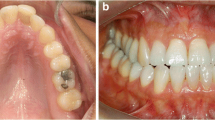Abstract
Objective
The aim of this study is to evaluate the efficacy of wing osteotomy for treating obstructive sleep apnea (OSA).
Materials and Methods
We performed mandibular wing osteotomy in subjects who had an apnea-hypopnea index (AHI) of more than 15, a previous unresponsive conservative treatment for the OSA, moderate to severe retrognathia and no suggested conventional orthognathic surgery because of dentition or lack of willingness. The subjects were evaluated using the Epworth Sleepiness Scale (ESS), AHI and posterior airway space (PAS) before and 1 year after surgery.
Results
We evaluated 10 subjects (4 males, 6 females) who underwent wing mandibular osteotomy. The mean age of the subjects was 37.8 ± 7.26 years. Analysis of the data demonstrated a significant change in ESS and AHI 1 year after operation. However, PAS was not changed 1 year after surgery. Results did not show any correlation between age, ESS and AHI before and 1 year after surgery.
Conclusion
Mandibular wing osteotomy is a novel procedure that improves signs of OSA. It may be a surgical option in retrognathic patients with OSA who are not candidates for conventional maxillomandibular advancement.


Similar content being viewed by others
References
Prinsel JR (2012) Obstructive sleep apnea—surgical treatment: part II, maxillomandibular advancement for adults. Current therapy in oral and maxillofacial surgery, Elsevier-Sanders 114:1048–1063
Powell N, Guilleminault C, Riley R, Smith L (1983) Mandibular advancement and obstructive sleep apnea syndrome. Bull Eur Physiopathol Respir 19:607–610
Holty JE, Guilleminault C (2010) Maxillomandibular advancement for the treatment of obstructive sleep apnea: a systematic review and meta-analysis. Sleep Med Rev 14(5):287–297
Dattilo DJ (1998) The mandibular trapezoid osteotomy for the treatment of obstructive sleep apnea: report of a case. J Oral Maxillofac Surg 56(12):1442–1446
Triaca A, Minoretti R, Saulacic N (2010) Mandibula wing osteotomy for correction of the mandibular plane: a case report. Br J Oral Maxillofac Surg 48(3):182–184
Schendel S, Powell N, Jacobson R (2011) Maxillary, mandibular, and chin advancement: treatment planning based on airway anatomy in obstructive sleep apnea. J Oral Maxillofac Surg 69(3):663–676
Goodday R, Bourque S (2012) Subjective outcomes of maxillomandibular advancement surgery for treatment of obstructive sleep apnea syndrome. J Oral Maxillofac Surg 70(2):417–420
Prinsell JR (2012) Primary and secondary telegnathic maxillomandibular advancement, with or without adjunctive procedures, for obstructive sleep apnea in adults: a literature review and treatment recommendations. J Oral Maxillofac Surg 70(7):1659–1677
Heller JB, Gabbay JS, Kwan D, O’Hara CM, Garri JI, Urrego A, Wilson LS, Kawamoto HK, Bradley JP (2006) Genioplasty distraction osteogenesis and hyoid advancement for correction of upper airway obstruction in patients with Treacher Collins and Nager syndromes. Plast Reconstr Surg 117(7):2389–2398
Bruno Carlo B, Mauro P, Silvia B, Enrico S (2008) Modified genioplasty and bimaxillary advancement for treating obstructive sleep apnea syndrome. J Oral Maxillofac Surg 66(9):1971–1974
Hendler BH, Costello BJ, Silverstein K, Yen D, Goldberg A (2001) A protocol for uvulopalatopharyngoplasty, mortised genioplasty, and maxillomandibular advancement in patients with obstructive sleep apnea: an analysis of 40 cases. J Oral Maxillofac Surg 59(8):892–897 Discussion 898–9
Santos Junior JF, Abrahão M, Gregório LC, Zonato AI, Gumieiro EH (2007) Genioplasty for genioglossus muscle advancement in patients with obstructive sleep apnea-hypopnea syndrome and mandibular retrognathia. Braz J Otorhinolaryngol 73(4):480–486
Riley RW, Powell NB, Guilleminault C (1989) Inferior mandibular osteotomy and hyoid myotomy suspension for obstructive sleep apnea: a review of 55 patients. J Oral Maxillofac Surg 47(2):159–164
Author information
Authors and Affiliations
Corresponding author
Rights and permissions
About this article
Cite this article
Tabrizi, R., Pourdanesh, F., Soleimanpour, M. et al. Evaluation of Mandibular Wing Osteotomy in Obstructive Sleep Apnea Cases with Retrognathia. J. Maxillofac. Oral Surg. 14, 46–50 (2015). https://doi.org/10.1007/s12663-013-0588-2
Received:
Accepted:
Published:
Issue Date:
DOI: https://doi.org/10.1007/s12663-013-0588-2




